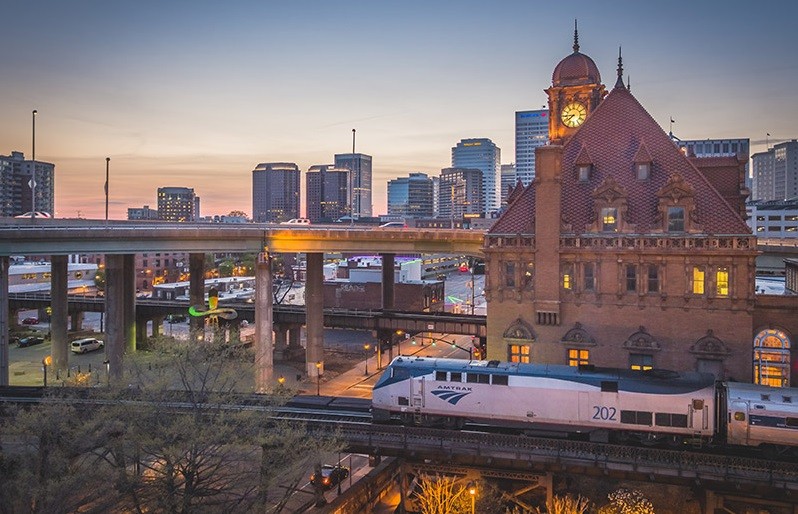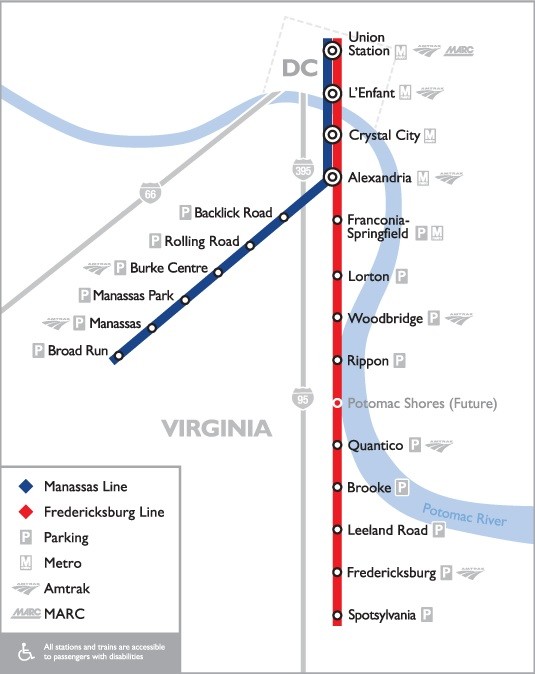Virginia won’t let anything derail its growing Amtrak service

Image by Amtrak used with permission.
This month marks a decade since Virginia debuted its first state-sponsored Amtrak routes: two lines from Lynchburg and Richmond that both terminate in DC. Such milestones are important, but the Commonwealth has other figures to celebrate—like the fact that its rail ridership has grown more than 7% within the last year.
That’s partly because there are more opportunities to ride. Virginia’s Department of Rail and Public Transportation (DRPT) expanded rail service to Hampton Roads by adding two more trains between Richmond and Norfolk, as well as one that travels to Newport News. The state is already planning a third Norfolk-bound train for 2021.
“There’s been a tremendous shift within the past five years towards multi-modal thinking,” said DRPT Director Jennifer Mitchell. “We are very focused on rail expansion in Virginia. It’s been a tremendous success so far. Our roads are so congested, we have to provide people alternatives to driving I-95, I-81, and I-64.”
This movement is exciting, but Virginia still has a ways to go before its train service is on par with its international neighbors, much less its regional ones.
There’s a lot of room for growth
On any given weekday, there are 40 Amtrak trains that leave from Baltimore, Maryland and head to the District of Columbia. Another 29 Maryland Area Regional Commuter (MARC) trains depart from Pennsylvania Station to our nation’s capital, and eight MARC trains make the journey to Washington from Baltimore’s Camden Station. By contrast, there are only two Amtrak trains that travel to DC from the Main Street Station in Richmond, Virginia each day.
Part of that disparity surely results from distance. While Baltimore lies just 40 miles northeast of the District, Virginia’s capital is three times further south. A quick glance abroad illustrates how shamefully underserved Richmond is, and how much better connected it could be.
Seventy-seven trains per day from Baltimore to DC may sound quite impressive. However, if we Americans invested in rail transportation as the Dutch do, we could have a mixture of local and express lines departing on average every eight minutes as is custom between Amsterdam and the Hague, which are also roughly 40 miles apart from one another. Such high-frequency service equates to nearly double the number of connections between the two cities each day.
The trip from Amsterdam to Groningen—the Netherlands’ seventh-largest city—is roughly 120 miles, the same distance from Richmond to DC. Instead of just two trains a day, passengers can head from Amsterdam to Groningen 42 times a day and at a cost of just $29.
While Dutch-style intercity service may be a pipe dream for now, officials across the Capital Region are working to make higher-speed rail and more frequent passenger and commuter service a reality within the next decade.
The Long Bridge overhaul will mean better train service
One key to better rail service between DC and Virginia? Alleviating local rail’s current bottleneck: the Long Bridge.
Currently, all DC-bound trains from Virginia have to pass over the Long Bridge, a 110-year-old rail crossing privately owned by CSX which spans the Potomac River between DC and Arlington. If the Long Bridge were to fail, the next closest north-south rail connection passes through Harper’s Ferry, West Virginia.
Image by Virginia Railway Express.
The critical nature of this connection across the Potomac means the Long Bridge is already at 98% capacity. If Virginia wants to add more Amtrak, Virginia Railway Express (VRE), or even freight trains into its statewide transportation portfolio, then the Long Bridge needs an overhaul.
“The Long Bridge is the connection between the entire Northeast and Southeast rail corridors. This is a project with national implications and impact,” said DRPT’s Mitchell.
Happily, the District Department of Transportation just released its environmental impact statement on Thursday, September 5, and Virginia looks poised to build keep the momentum going.
Long Bridge by Rex Block used with permission.
Current plans envision a new two-track bridge just upstream of the existing Long Bridge. The new, publicly-held bridge would be dedicated to passenger and commuter service, while the old bridge would carry all freight traffic along the corridor. The full expansion plans cover a 1.8-mile stretch and would add two new tracks to Union Station to support northbound Amtrak and VRE service, as well as two more tracks that would veer east to the Virginia Avenue tunnel that serves freight.
To take full advantage of this added capacity, Virginia plans to build out its network by adding a third set of tracks from Lorton to Franconia in the south, as well as a fourth from Alexandria to the Long Bridge.
“This second project is about creating more capacity and more reliable service, and it goes hand-in-hand with the Long Bridge [project] to expand rail across the state,” explained Mitchell.
Without this additional expansion, there won’t be enough clearance available to support the much-touted DC2RVA High Speed Rail. The final Record of Decision on Virginia’s DC2RVA plans was released Sept. 5, revealing plans to build out track almost all the way from DC to Richmond (except through Ashland) and add nine roundtrips per day, four of them continuing to North Carolina.
Challenges in Central Virginia
Solving Northern Virginia’s capacity issues won’t be enough to increase connectivity between Richmond and DC. For that, Central Virginia will have to tackle its own challenges.
Today, two lines pass through the River City. The A Line veers west via Staples Mill; it currently handles all rail traffic to Raleigh and beyond. The S Line stops at Main Street Station downtown and continues onward to Hampton Roads without linking back up with the rest of the Southeastern network. In order to make higher-speed rail from DC to Raleigh truly useful, the S Line serving Richmond’s Main Street Station will need to be connected back to Amtrak’s main A Line further south, likely before the Ettrick Station in Chesterfield.
A lot of new infrastructure will be required in order to switch all southbound traffic to the S Line. This new configuration would make Staples Mill Richmond’s more suburban commuter station with large amounts of parking and Main Street Station Richmond’s most served terminal nestled firmly within its downtown.
Thankfully, Virginia is one of the few states that has dedicated rail funding. Nonetheless, local lawmakers are eyeing another way to pay for the necessary investments. After last year’s General Assembly session sealed a deal to create a dedicated funding stream for the I-81 corridor, Central Virginia became the only region in the Commonwealth lacking a mechanism to generate revenue for transportation and transit projects.
To see if Virginia’s lawmakers are as serious about rail as its bureaucrats, one need only wait till next session in 2020.
